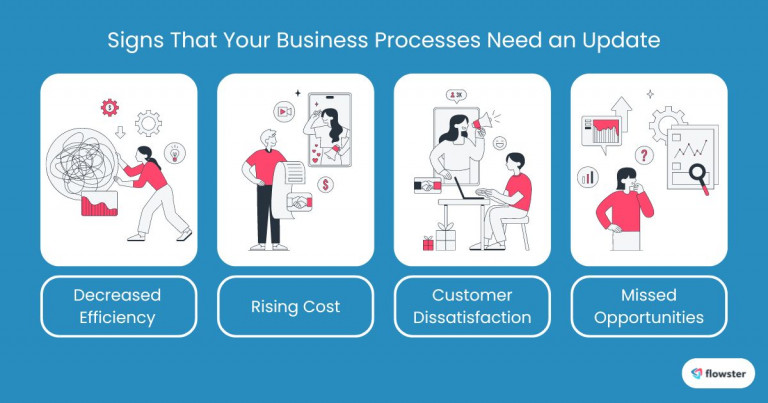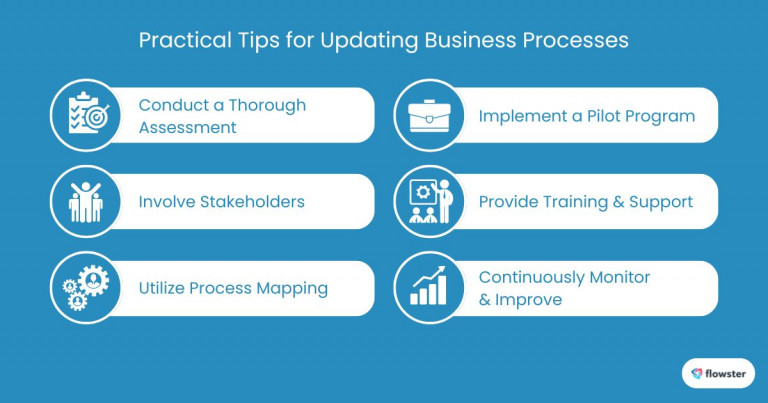In today’s fast-paced business environment, staying competitive requires continuous adaptation and improvement. One crucial area that often needs attention is updating business processes. Outdated processes can lead to inefficiencies, increased costs, and decreased customer satisfaction. Conversely, well-designed and updated processes can drive efficiency, productivity, and customer satisfaction, ultimately enhancing a business’s competitiveness.
This comprehensive guide aims to provide valuable insights into when and how to effectively update business processes. We will explore the key signs that your processes may be in need of an overhaul, the challenges you may encounter during the update process, the significant benefits that can be achieved, and practical tips to ensure a successful implementation. By following the guidance provided in this blog post, you can take a proactive approach to process improvement and position your business for long-term success.
Article Outline
Signs That Your Business Processes Need an Update
Are Your Business Processes Holding You Back?
If you’re noticing a decline in efficiency, productivity, or customer satisfaction, it may be a sign that your business processes are outdated. Let’s explore some common indicators that it’s time for a process update.
Decreased Efficiency
- Delays and bottlenecks: Outdated processes can create bottlenecks and delays, leading to longer wait times and decreased overall efficiency.
- Repetitive tasks: Manual, repetitive tasks can consume valuable time and resources, hindering productivity.
Rising Costs
- Increased operational expenses: Inefficient processes can lead to higher operational costs due to wasted resources, rework, and errors.
- Reduced profitability: Rising costs can erode profit margins, making it difficult for businesses to remain competitive.
Customer Dissatisfaction
- Poor customer experience: Outdated processes can result in a poor customer experience, leading to decreased customer satisfaction and loyalty.
- Negative reputation: Negative customer experiences can damage a business’s reputation and make it difficult to attract new customers.
Missed Opportunities
- Inability to adapt to change: Outdated processes may prevent businesses from adapting to rapidly changing market conditions and seizing new opportunities.
- Competitive disadvantage: Failure to update processes can put a business at a competitive disadvantage, as competitors may be able to leverage more efficient and effective approaches.
If you recognize any of these signs in your business, it may be time to re-evaluate your existing processes and consider implementing updates. By addressing these issues, you can improve efficiency, reduce costs, enhance customer satisfaction, and position your company for long-term success.

Challenges of Updating Business Processes
Implementing changes to business processes can be a complex undertaking, often accompanied by various challenges. Overcoming these obstacles is crucial for a successful update and achieving the desired benefits.
Resistance to Change
- Fear of the Unknown: Employees may resist changes to familiar processes due to fear of the unknown or concerns about job security.
- Disruption to Routine: Implementing new processes can disrupt daily routines and require employees to learn new skills or adapt to different ways of working.
- Overcoming Resistance: To address resistance to change, it is important to communicate the benefits of the updates clearly, involve employees in the process, and provide adequate training and support.
Resource Constraints
- Limited Budget: Updating processes can require significant financial resources for investments in technology, training, and consulting services.
- Time Constraints: Implementing changes can be time-consuming, and businesses may face challenges in allocating sufficient resources to the process.
- Prioritizing Updates: To overcome resource constraints, it is important to prioritize updates based on their potential benefits and the impact they will have on achieving strategic goals.
Lack of Expertise
- Internal Knowledge Gaps: Businesses may lack the internal expertise or skills required to design, implement, and manage new processes.
- Outsourcing or Consulting: In such cases, it may be necessary to consider outsourcing or consulting with external experts to provide the necessary guidance and support.
- Building Internal Capabilities: Over time, businesses can invest in building internal capabilities and developing the necessary expertise to handle process updates.
While these challenges can be significant, they can be overcome with careful planning, effective communication, and a commitment to process improvement. By addressing these obstacles head-on, businesses can successfully update their processes and reap the rewards of increased efficiency, productivity, and customer satisfaction.
Flowster's AI-Driven Automation
Benefits of Updating Business Processes
Updating business processes can yield significant benefits for organizations, including improved efficiency, reduced costs, enhanced customer satisfaction, and increased competitiveness. By investing in process updates, businesses can position themselves for long-term success.
Increased Efficiency
- Streamlined Operations: Updated processes can eliminate redundancies, reduce bottlenecks, and streamline operations, leading to improved efficiency.
- Time Savings: By optimizing workflows and minimizing unnecessary steps, businesses can save valuable time and resources.
Reduced Costs
- Cost Savings: Improved efficiency and reduced waste can lead to significant cost savings, enhancing profitability.
- Optimized Resource Allocation: By identifying and eliminating inefficiencies, businesses can allocate resources more effectively.
Enhanced Customer Satisfaction
- Improved Customer Experience: Updated processes can result in faster response times, reduced errors, and a more personalized customer experience.
- Increased Customer Loyalty: Satisfied customers are more likely to remain loyal to a business and recommend its products or services.
Improved Competitiveness
- Stay Ahead of the Competition: Updated processes can help businesses stay ahead of the competition by enabling them to adapt to changing market conditions and seize new opportunities.
- Enhanced Innovation: Efficient and effective processes can foster a culture of innovation and creativity, enabling businesses to develop new products and services.
By investing in updating business processes, organizations can reap numerous benefits, including improved efficiency, reduced costs, enhanced customer satisfaction, and increased competitiveness. These benefits can contribute to long-term success and sustainable growth.

Practical Tips for Updating Business Processes
Implementing successful business process updates requires a systematic and strategic approach. By following these practical tips, organizations can navigate the challenges and maximize the benefits of process improvement.
Conduct a Thorough Assessment
- Identify Areas for Improvement: A comprehensive assessment of current processes is essential to identify areas that need updating and to understand the root causes of inefficiencies.
- Data-Driven Analysis: Utilize data and analytics to gain insights into process performance, identify bottlenecks, and measure key metrics.
Involve Stakeholders
- Build Buy-in: Engaging employees and other stakeholders in the process update can foster a sense of ownership and increase buy-in.
- Leverage Diverse Perspectives: Incorporating input from various stakeholders can help identify potential challenges and ensure that the updated processes align with organizational goals.
Utilize Process Mapping
- Visualize Processes: Process mapping tools can help visualize complex processes, identify redundancies, and identify opportunities for improvement.
- Optimize Workflows: By understanding the flow of work, organizations can streamline processes, eliminate bottlenecks, and improve efficiency.
Implement a Pilot Program
- Test on a Smaller Scale: A pilot program can help test new processes on a smaller scale before full-scale implementation, allowing for identification and resolution of potential issues.
- Refine Implementation Plan: The insights gained from the pilot program can be used to refine the implementation plan and ensure a smooth rollout.
Provide Training and Support
- Equip Employees: Ensure that employees have the necessary training and resources to effectively use new processes.
- Address Concerns: Provide ongoing support to address questions and concerns and help employees adapt to the changes.
Continuously Monitor and Improve
- Measure Performance: Regularly monitor and evaluate the performance of updated processes to ensure they are delivering the desired results.
- Identify Areas for Further Improvement: Use data and feedback to identify areas for further improvement and make ongoing adjustments.
By following these practical tips, organizations can effectively update their business processes, drive efficiency, improve customer satisfaction, and enhance their overall competitiveness.
Capture Your Processes in Minutes!
Conclusion: A Roadmap for Successful Process Updates
Updating business processes is a critical step in ensuring organizational success in today’s competitive landscape. By following the guidance provided in this blog post, you can effectively identify areas for improvement, address challenges, and reap the benefits of process updates.
Key Takeaways:
- Recognize the Signs: Be aware of the signs that your processes may be outdated, such as decreased efficiency, rising costs, customer dissatisfaction, and missed opportunities.
- Address Challenges: Overcome common challenges like resistance to change, resource constraints, and lack of expertise.
- Leverage Benefits: Embrace the benefits of updated processes, including increased efficiency, reduced costs, enhanced customer satisfaction, and improved competitiveness.
- Implement Best Practices: Utilize practical tips such as conducting thorough assessments, involving stakeholders, utilizing process mapping, implementing pilot programs, providing training and support, and continuously monitoring and improving.
Take Action Today:
Don’t wait for problems to arise. Assess your current business processes and identify areas for improvement. By implementing updates, you can streamline operations, reduce costs, enhance customer satisfaction, and position your business for long-term success.
Get Started with Free Business Process Templates:
To help you on your journey, we offer free business process templates and SOP templates from Flowster Marketplace. These templates can provide a solid foundation for your process updates and streamline the implementation process.
By taking proactive steps to update your business processes, you can drive innovation, improve performance, and ensure your organization’s continued success.




